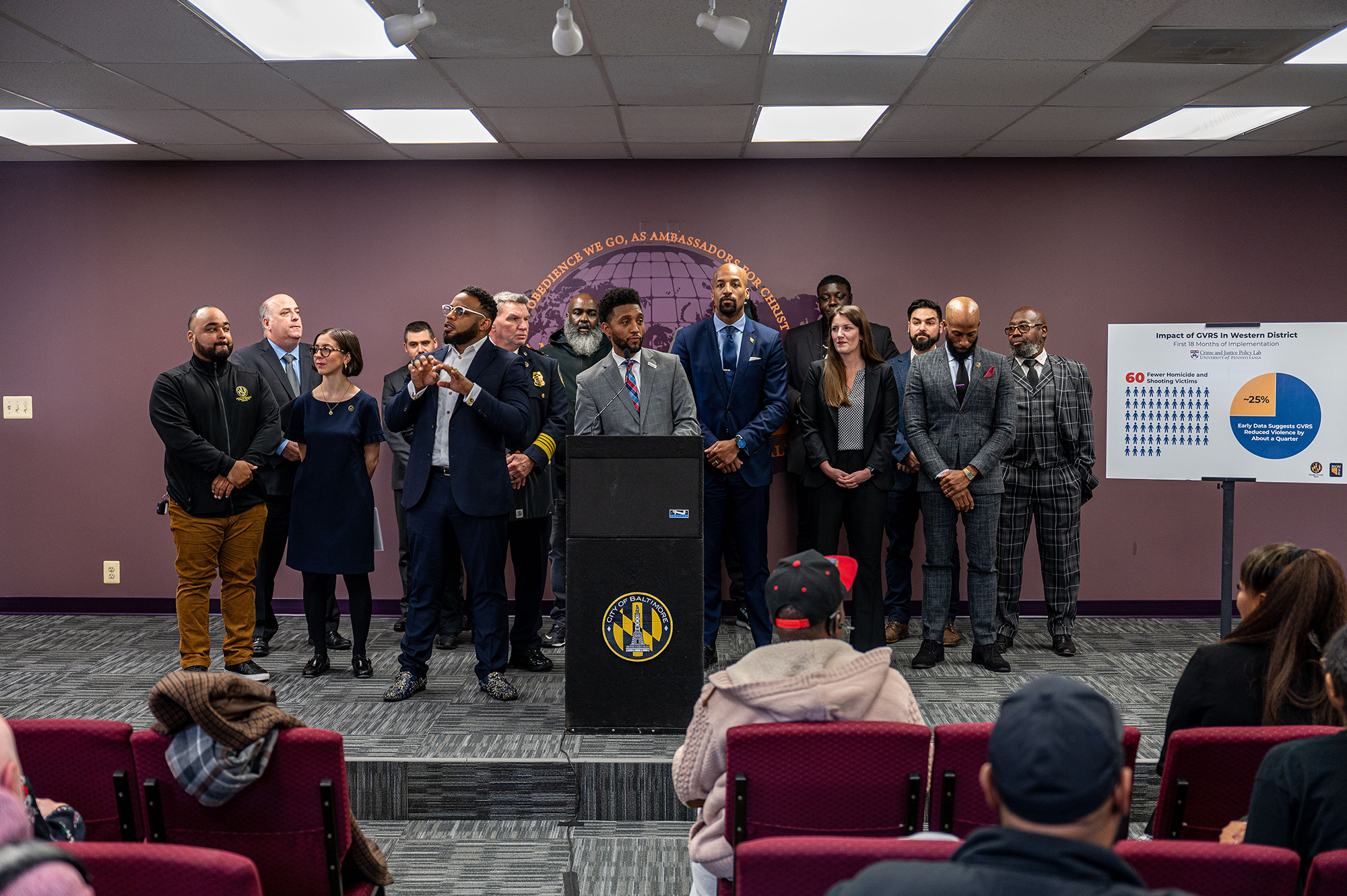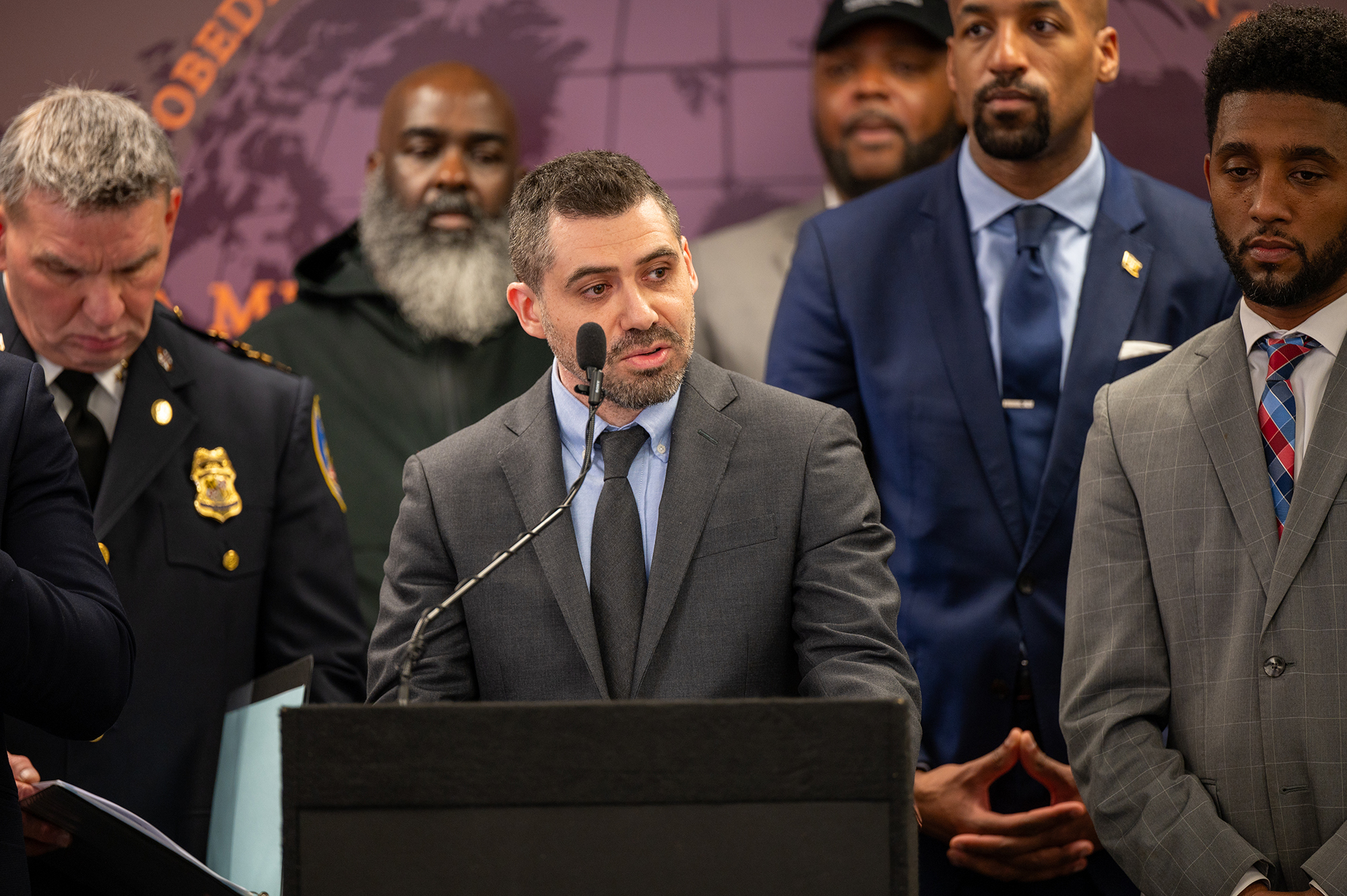The Baltimore Police Department’s Western District has historically had the highest rates of homicides in the city and among the highest in the country. Looking through Baltimore crime data from 2020, Anthony Braga, the Jerry Lee Professor of Criminology at the University of Pennsylvania, points out that nearly 70% of all homicides involved a group member, such as a person in a gang, drug-selling crew, or robbery group.
“Violence propagates through social networks and in a social manner, almost like a virus,” says Brian Wade, senior data scientist in Braga’s Crime and Justice Policy Lab (CJP) at Penn. He specifically moved to Baltimore to work on the city’s Group Violence Reduction Strategy (GVRS), which he compares to contact tracing at the height of the COVID-19 pandemic.
For example, the city sends police officers, community members, and someone from the Mayor’s Office of Neighborhood Safety and Engagement (MONSE) to deliver a “custom notification” to a person close to the victim of a shooting, Wade says. The team explains what wraparound services are available, such as transitional employment, substance abuse treatment, and mentoring, but also provide a warning about the legal consequences if the person retaliates. They also work with street outreach workers from youth violence reduction nonprofits Roca Inc. and Youth Advocate Programs.
Wade has gone to a lot of the 175 individual interventions conducted during the first 18 months of implementation in the Western District, often at the person’s house or a place where they hang out. Ninety people at the highest risk of shooting someone or being shot have accepted services through GVRS.
The Group Violence Reduction Strategy was introduced in Baltimore in January 2022, and 18 months later the CJP estimates it was responsible for reducing homicides and shootings by about 25%—the equivalent of 60 fewer victims—and carjackings by more than 30%, compared to what they would have been without GVRS. There is no evidence that crime moved elsewhere in the city, a concern among residents, and preliminary analysis shows no increase in arrests.
“The Baltimore work is so significant to the national conversation on crime and criminal justice because what we’ve shown is you can really reduce serious violence in a city without increasing arrests, and so many people I talk to think there’s this necessary tradeoff,” says Ben Struhl, executive director of CJP.
“In many cities, it’s as small as 1 or 2% of the city generating between 40 and 60% of all the homicides and shootings,” Braga says, “and these individuals are often very disconnected from opportunities. They’re caught up in this set of norms around violence as a means to settle situations that they have a very difficult time getting out of.”
The strategy expanded to the Baltimore Police Department’s Southwestern District in January 2023 and to the Central District in January 2024. Mayor Brandon Scott and city partners have laid out a timeline to reach the city’s remaining police districts by the end of 2024, and preparation is already underway for expansion to the Eastern District.
“Every metric we have is showing that this strategy is working,” said Scott, speaking at a recent press conference in Baltimore on the results. “Now is the time to keep up the momentum so that we can continue making our neighborhoods safer for everyone in the right way.”
Success in other cities
Braga explains that GVRS, a strategy known beyond Baltimore as focused deterrence, started in Boston with Operation Ceasefire in the 1990s. Braga worked on that strategy, which resulted in a 63% reduction in youth homicides and became known as the Boston Miracle. Braga says it was called a miracle not only because of the large reduction in violence, but also because it was innovative to have clergy partnering with police to do youth violence prevention work.
The success of Operation Ceasefire grew into the National Network for Safe Communities (NNSC) at John Jay College. Struhl explains that NNSC helped Philadelphia launch its own Group Violence Intervention (GVI) strategy in parts of Philadelphia in 2020 and 2021, based on research and implementation from Boston, Chicago, Los Angeles, and Oakland, California. The city previously implemented GVI in South Philadelphia from 2012 to 2016.
Philadelphia enlisted Penn to provide a third-party evaluation of the 2020 program. CJP researcher Ruth Moyer’s analysis, released in February 2023, found that GVI reduced violence among groups reached, but it had not attained the scale necessary to change the trajectory of violence throughout the city.
Implementing the strategy in Baltimore
Braga says the City of Baltimore reached out to him in 2019, when he was a professor at Northeastern University and running the Center on Crime and Community Resilience. He brought that center with him when he came to Penn in July 2021, turning it into the CJP.
“The Department of Criminology and the School of Arts & Sciences were very committed to getting an action-oriented research center that blended rigorous scientific analysis and practical partnerships with cities and communities to tackle crime and justice problems,” Braga says. “The work of the lab has been turbo-charged since coming here, in terms of opportunities.”
Terence Nash, who works in MONSE as the deputy director of GVRS, describes focused deterrence as identifying the people and social networks responsible rather than just having police on every corner in certain areas, which he describes as more resource-intensive and not well-accepted in the neighborhood.
“If you could offer someone services to make their life better, that’s far better than a law enforcement angle,” Nash says, “and it also allows for those limited law enforcement resources to be more focused on those individuals that refuse to obey the mandate of not engaging in gun violence.”
He meets at least once a week with the members of the team from Penn, who he says have been very insightful. “It’s great to know what the best practices are throughout the country and what’s worked over the past 20 years based on the research that’s been developed,” he says. “They’ve been very useful in developing the tools for management and the structure of the governance model.”
Braga says Mayor Scott “saw a tremendous amount of potential for the work, and he made implementing it—and implementing it in a robust and serious manner—part of his platform to get elected. He was very serious about it, he understood the approach, and he’s been terrific.”
Wade began his work by going into the neighborhoods in the Western District, before spending time in City Hall and then interviewing police officers and community partners, from local clergy to tenant association presidents to youth sports coaches.
“One thing we’re really interested in understanding is the extent to which there is congruence in how the police perceive the violence problem in the city, how the community perceives the violence problem, how the guys that are involved perceive the violence problem, and how city officials perceive the violence,” he says.
Analysis and next steps
Aaron Chalfin, associate professor of criminology at Penn, is leading the statistical analysis of the intervention’s impacts along with Cornell University economist Max Kapustin. This has involved analyzing homicides, shootings, assaults, robberies, and carjackings from January 2015 to June 2023.
Their analysis is looking at trends in the Western District relative to the rest of the city and using synthetic controls, which Braga describes as “an approach where you construct a synthetic version of the Western District using other areas in the city with similar levels of violence and similar recent trends.” That allows researchers to see what the Western District might have looked like without the intervention during the same period.
“We’re seeing a very low revictimization rate for people who have been engaged and a very low recidivism rate, which means the strategy is keeping true to its goal of safe, alive, and free,” says Jeremy Biddle, Baltimore project director for the CJP. With offices in the mayor’s office and police department, he advises city officials in management meetings, including a weekly review of shootings and potential for retaliation, and works with service providers.
Biddle says the “sad reality” for people who do violence reduction work in any city is that they don’t know what will happen when political administrations change. “You just don’t know about the longevity of these things,” he says, “but what we’re trying to do is bake it enough into the way the city manages violence that it has staying power.”
The Baltimore research team from the Crime and Justice Policy Lab at Penn also includes Christina Layana, a senior data scientist; Deborah D’Orazi, project coordinator; and Alexa Mason, program associate.
The Crime and Justice Policy Lab has gotten funding for its Baltimore work from the Abell Foundation, the Baltimore Community Foundation, Johns Hopkins University, the Goldseker Foundation, the Brown Advisory Board, the Jacob and Hilda Blaustein Foundation, the Crane Foundation, the France Merrick Foundation, and the Krieger Fund.









